
The Fender 400-PS FAQ

The Fender 400-PS FAQ
The Questions:1. Is the 400-PS a Bass or a Guitar amp?
2. I've heard that the 400-PS is very problem-matic.
3. Why do I have to use those high priced GE-6550A's?
4. Are all 6550's the same?
5. What test equipment do I need to setup a 400-PS?
6. How much power does the 400-PS really put on the speakers?
7. Why does the 400-PS have three 145 watt speaker outputs? (short version)
7. Why does the 400-PS have three 145 watt speaker outputs? (long version)
8. What are those "Power Piston" speakers you talk about?
9. What are the best type of speakers and cabinets to use with a 400-PS?
10. Can I get all the power of the 400-PS on one cabinet?
11. What's so special about the 400-PS experience?
12. Can I ship my 400-PS to you for repairs?
13. Is there some way you can help my amp tech repair my 400-PS?
14. How can I find out when my 400-PS was made?
15. How can I find out what my 400-PS is worth?
16. Are there any mods that can be done to the 400-PS?
17. I found a broken down 400-PS for sale. Do you think I should buy it?
18. What are the best basses to use with a 400-PS?
19. My solid state amp blew speakers often. Will the 400-PS do the same?
20. Did any famous bands use the 400-PS amp?
21. Are there any Do's and Don'ts I should know about when using a 400-PS?
22. What are the Fender specs for the 400-PS?
23. What is the advantage of having a 400-PS over an SVT?
24. What output stage CLASS of operation is used in the 400-PS?
25. Can the KT-88, or other output tubes be used in the 400-PS?
The Answers:1. Is the 400-PS a Bass or a Guitar amp?
(This email was found in my mailbox,... which speaks for itself)2. I've heard that the 400-PS is very problem-matic.
Subject: Re: Fender 400PS
Date: Wed, 16 Feb 2000 08:45:10 GMT
From: "ALAN THOMPSON" <zambiwoof@xxxx.com>I had the pleasure of hearing Albert King blazing through one of these monsters years ago at an outside concert in Phoenix (the amp was supplied by the local promoters). Imagine Albert with a screaming Hendrix tone and that about nails it. Awesome. Taj Mahal was sitting next to me, he was jumping up and down and yelling all through the show.
At one point Albert held a sustained note through the complete twelve bars of a song, and then deftly bent it down into a cool turnaround, the audience was on the edge of their seats through the whole thing and reacted crazily when he finally completed
the lick.What a show! It's hard to remember now, but I think they had it
going through a couple of Dual Showman cabs, so it was only using 2/3 of the available power.A.T.
Used as a keyboard amp, the 400-PS is just amazing with the full range JBL Showman speaker cabinets.Used as a bass instrument amp, with the properly selected speakers and cabinet, it becomes the awesome vacuum tube bass amplifier on the planet.
I have found that it is most often the users and amp techs who cause
the problem, in the 400-PS to appear to be problem-matic.Users who don't want to be bothered following the rules that go along with owning and operating a 400-PS, seem to think that the same rules that apply to owning and operating a 100 watt Fender Bassman, or even the 300 watt Ampeg SVT, automatically applies to the 400-PS. Mistakenly thinking that the 400-PS is in the same class of amplifier.
They couldn't be more wrong, and...
Amp Techs who seem to think that if they know how to work on a 100 watt Fender Bassman or even the 300 watt Ampeg SVT, that this automatically qualifies them to work on the 400-PS. Thinking that the 400-PS is in the same class of amplifier.
They couldn't be more wrong.
It is for this reason, the 400-PS amplifier gets it's undeserved problematic reputation, and never ending bashing.
The 400-PS is a one of a kind amplifier, with its own set of rules to follow.
When you understand and follow these rules, the 400-PS is no more problematic than a Fender Bassman.
3. Why do I have to use those high priced GE-6550A's?You don't HAVE to do anything.
But, when you do the proper thing, it's a nice thing.
Then... everything works as it should.It's like anything else, when specific things are designed to work together to yield the "maximum" in performance with long service life. This is the case with the 400-PS with the original Tungsol 6550, as well as with the even higher performance GE-6550A.
Likewise, the high performance Musicman amps were specifically designed to run the Sylvania 6CA7 tube, because of their well known superior performance and service life.
In both cases, no other tubes were considered for use in these amps. Not even as a substitute replacement tube.
A year or so back I had a 400-PS owner stop in with a set of NEW Russian 6550WE tubes to be installed. I really had to play games with that 400 to get those tubes to run. This was their best day right out of the box for these tubes, and the best they could do was 124 watts per load at 100 Hz for a 372 watt total output from a conservatively 435 watt rated amp.
After 72 hours of hard dynamic signal running time and a re-adjustment, that 372 watt total figure dropped by almost 50 watts.
It's one thing to print the specs for a tube, and quite another to make the tubes that live up to those specs with LONG continued service life.
Here are the GE-6550A data sheets for you to see if the other so called 6550's measure up to the high performance GE-6550A standard.
High performance with long service life is the hallmark of the GE-6550A.
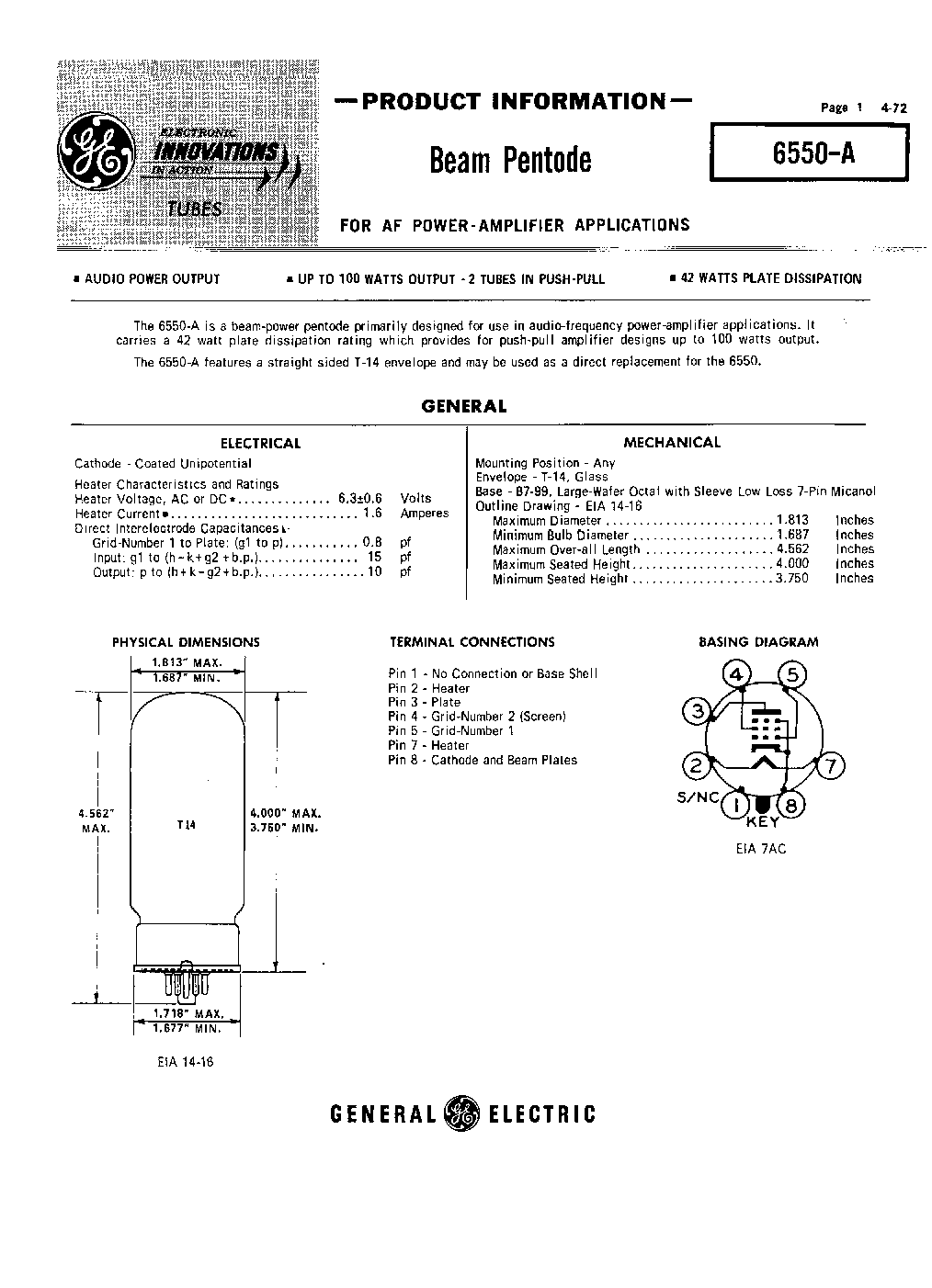
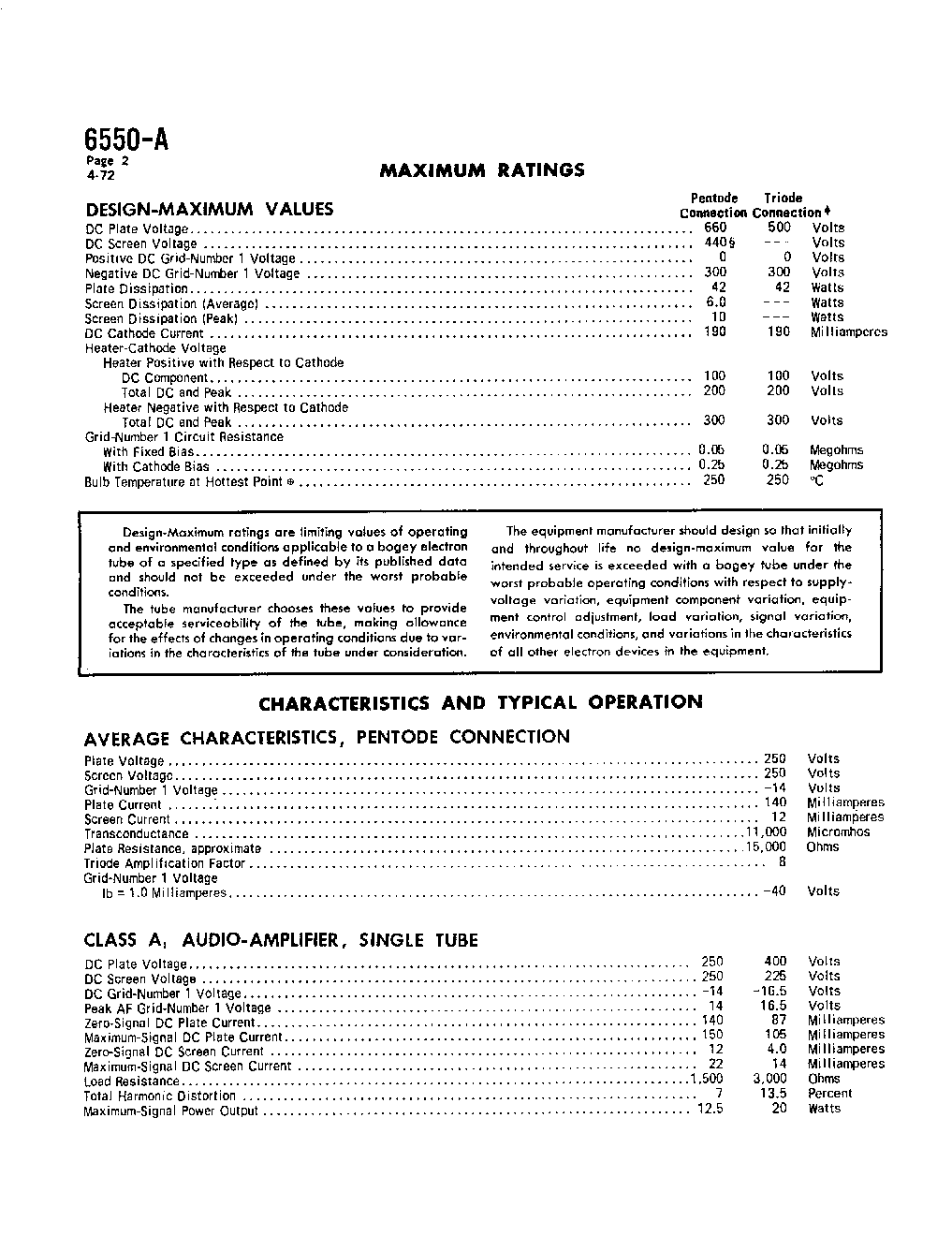
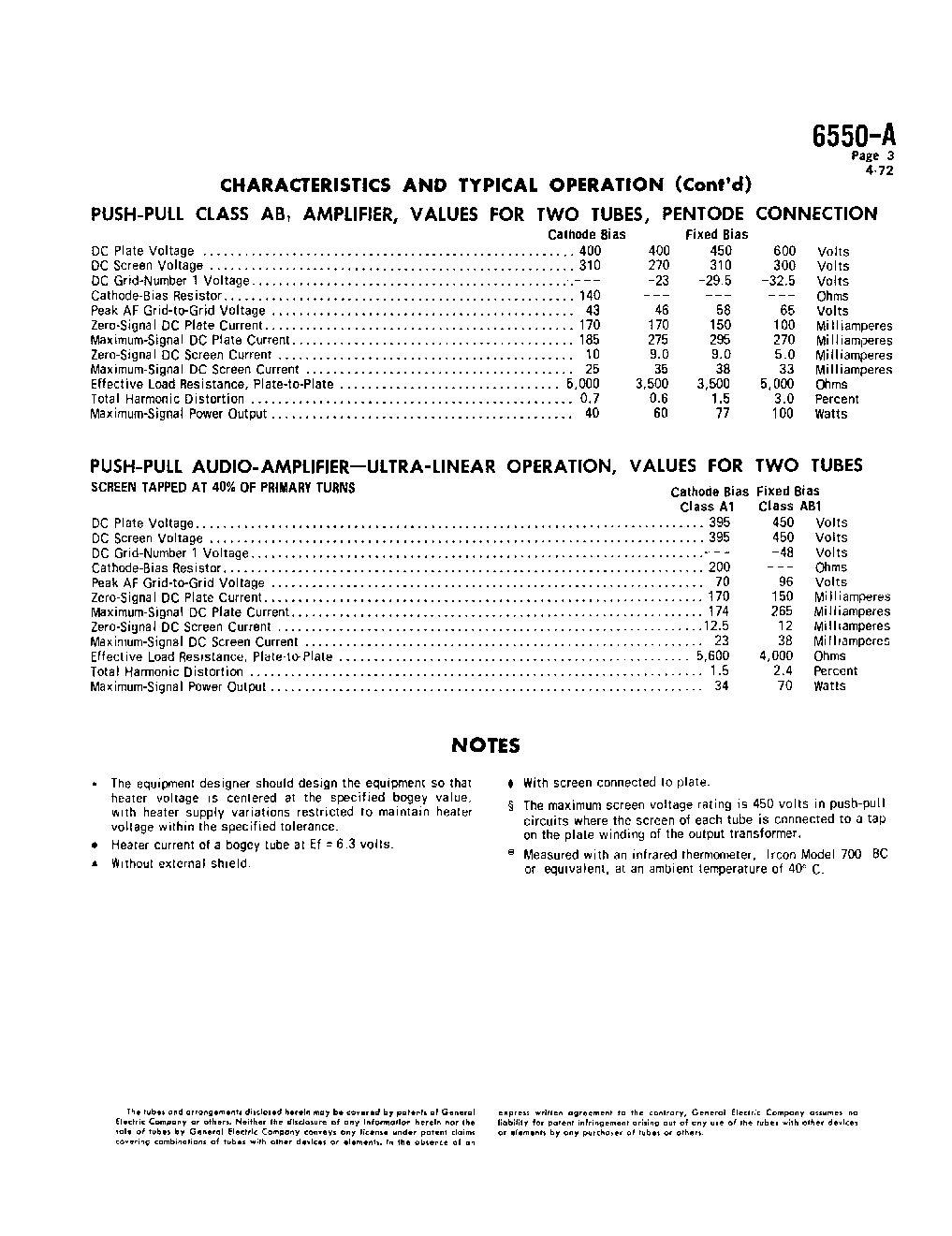
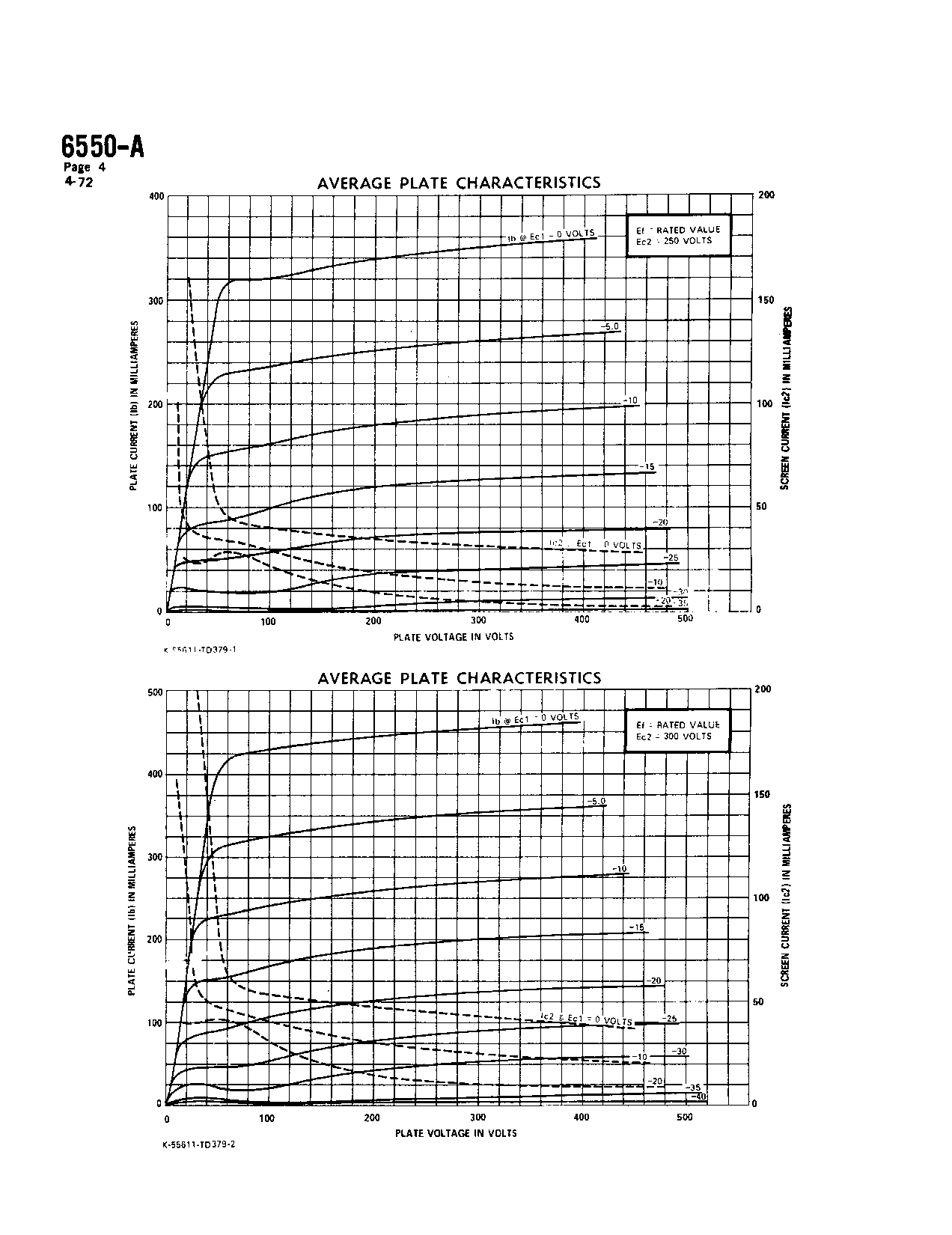
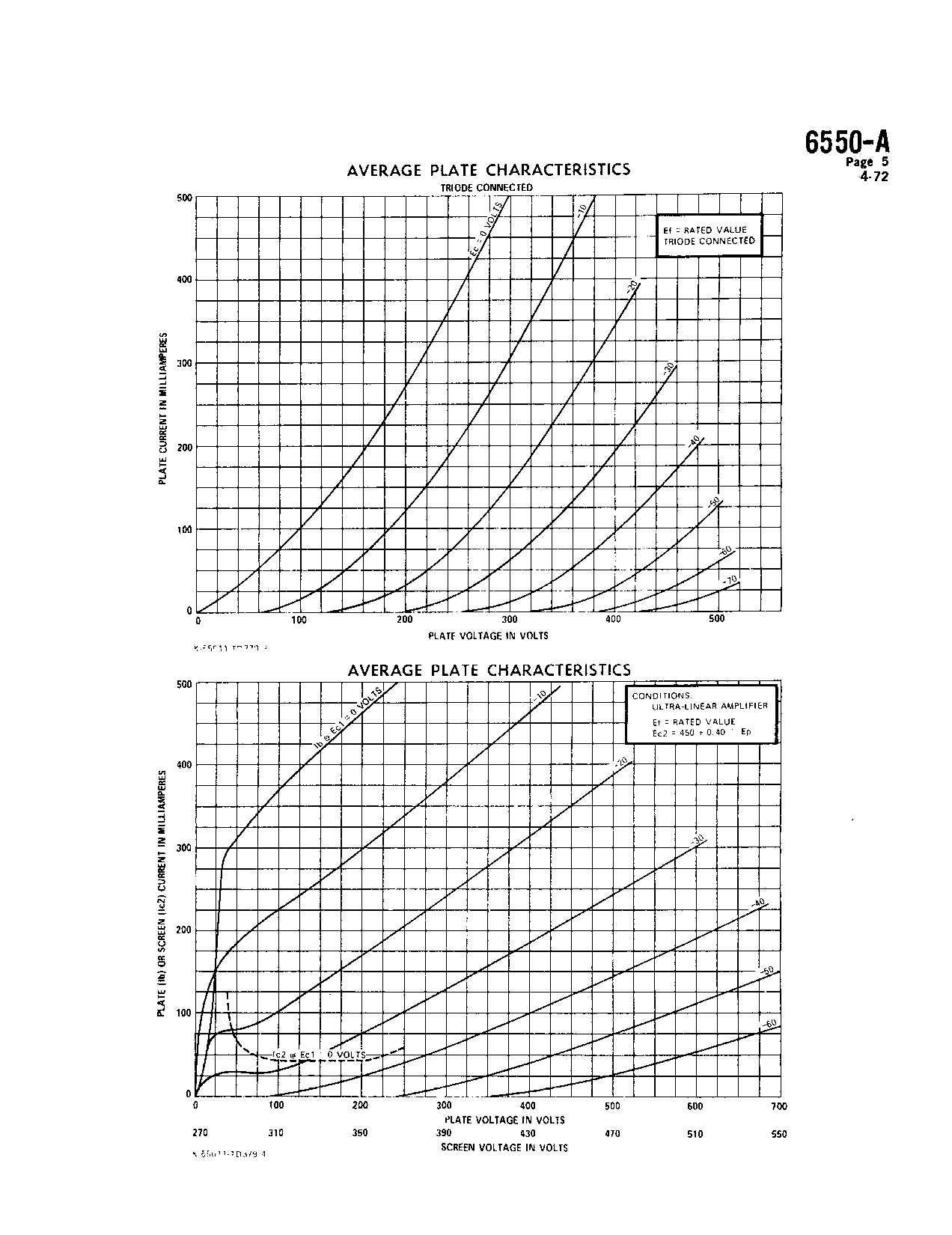
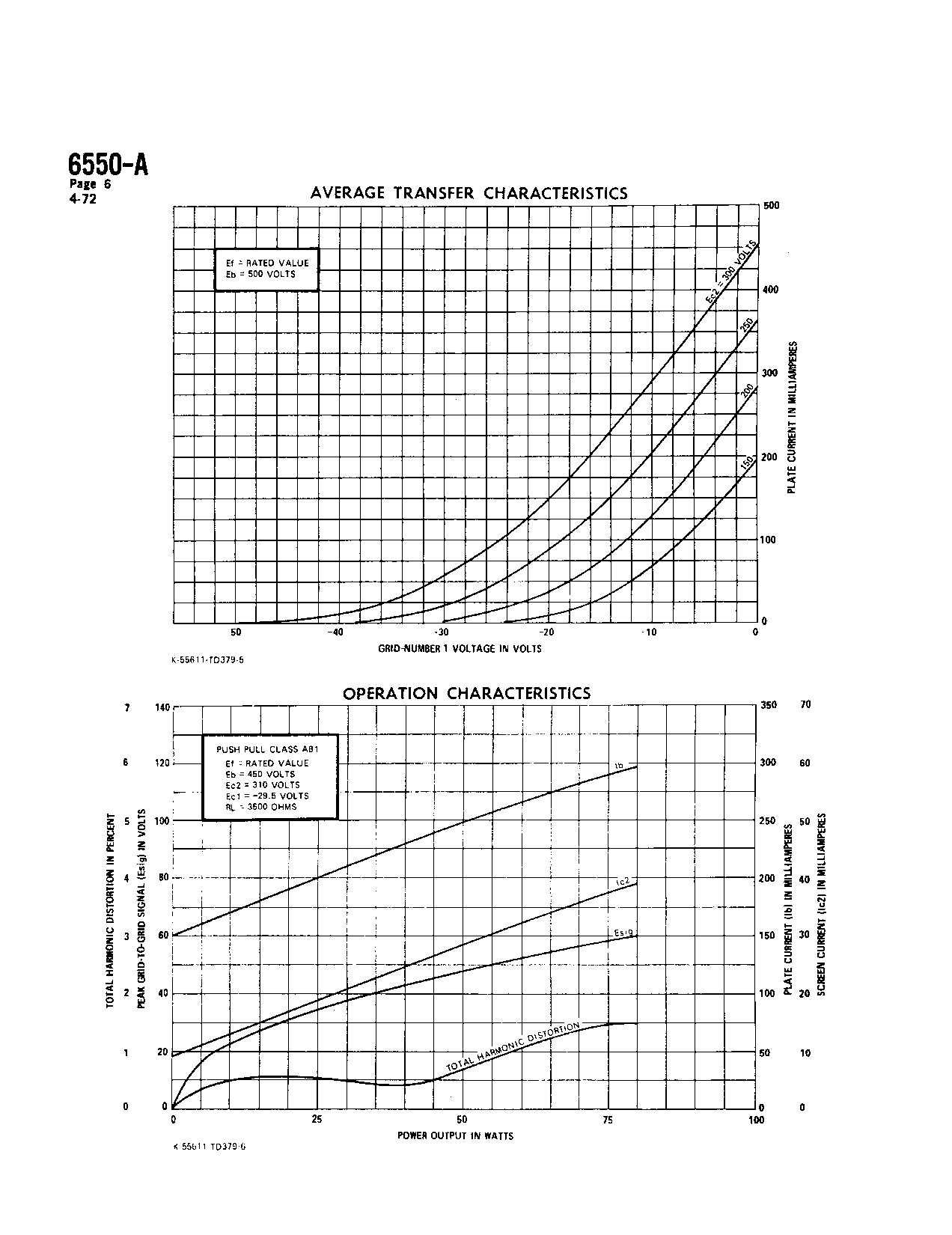
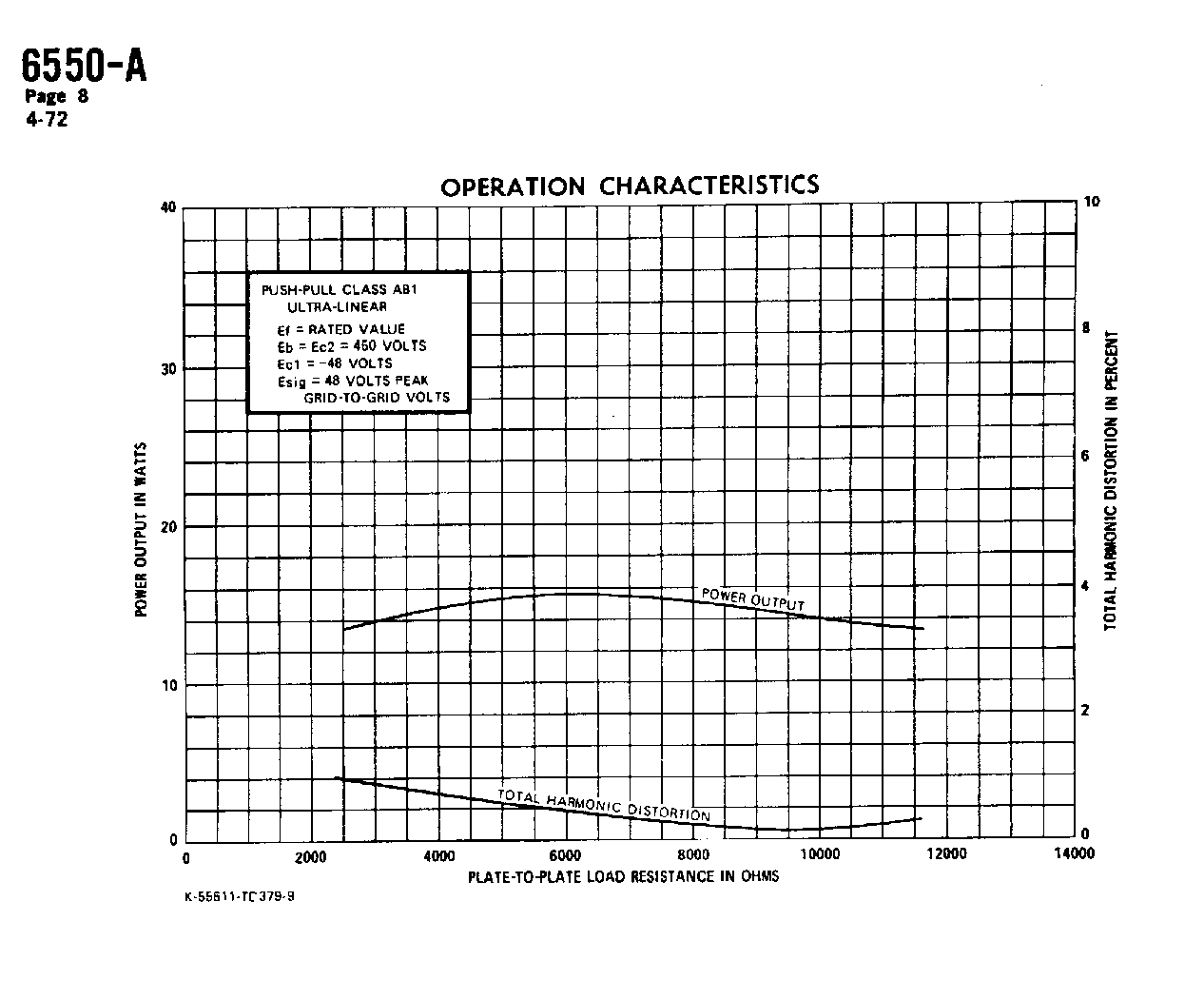
No, for the following reasons.With the way tubes are being made in other countries today, there is little chance of any of the same type of tubes ever being made the same from one country to another.
There are no unifying standards behind what they produce with respect to standards that cover their manufacturing methods, material standards, or operational electrical performance characteristics.
In the USA we had government specifications, with industry's material standards and testing practice for the vacuum tube, and an electronics industry's standard to follow. Not all tube companies were qualified to supply specific vacuum tube products to the government of the USA.
The rest of the world's tube companies *individually* brand what ever they think their tube is, for THEIR standard for a tube type. This most often is different country to country, and can change from production run to production run.
This is why we have the problems with same type vacuum tube performance being all over the map from off shore today.
For example, if they can't even make a tube with the right size pins for our USA tube sockets, would you expect them to have the correct electrical characteristics dead-on spec for a Sylvania or GE of the same branded type of tube?
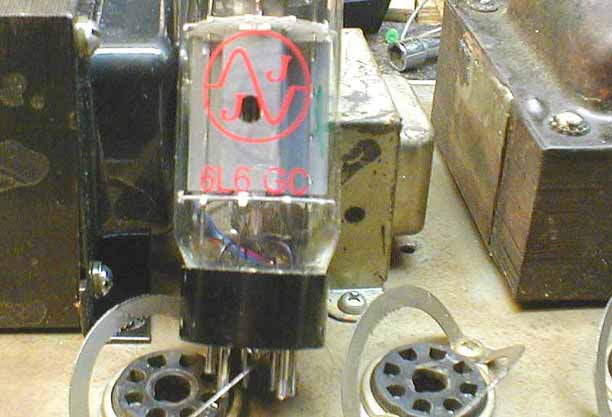
These over sized base pins were broken off by a customer who could not get this tube in the socket of his Fender Twin Reverb. These tubes should have never been sold in the US market place.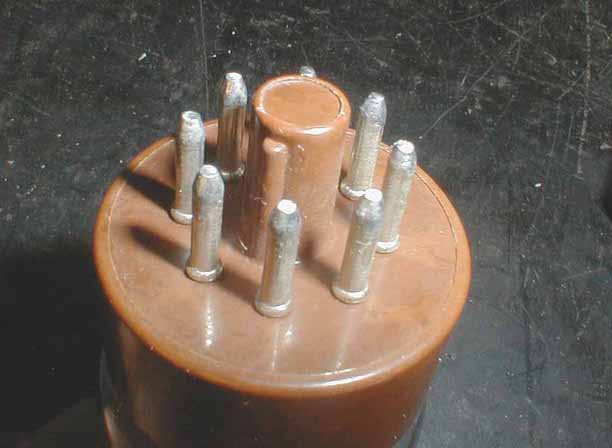
If USA industry standards were on the minds of those who make the vacuum tubes from off shore, I would not have had to re-base these tubes to fit the sockets made in the USA, and you would not have these pictures to look at on this FAQ page.
5. What test equipment do I need to setup a 400-PS?TEST EQUIPMENT REQUIRED:1- 0 to 150 volt 60 Hz A.C. voltmeter 2% accuracy
1- G.R. Variac type W10M, 13A 0-140v.
1- Weston 0-10 Amperes Iron Vane R.M.S. meter model 1944-2%
1- H.P. 120B oscilloscope (or equivalent)
1- H.P. 200AB Audio Oscillator (or equivalent)
1- General Radio 546 Micro voltmeter (or equivalent)
3- 4 ohm 160 watt load resistors
3- Weston 1942 series 0-25 volts 2% accuracy rectifier type A.C. meters
3- Heavy duty cables of #14 flexible wire (5 ft. maximum) and associated
connectors for output hookup
1- Dummy load for reverb test (consisting of actual reverb input coil
assembly mounted in box with two (2) phono connectors for output
hookup.
1- H.P. 400 E RMS meter (or equivalent)
1- Weston model 1241 D.C. volt-ohmeter (or H.P. 412 V.T.V.M. if in house)
plus necessary shielded cables for input, reverb, etc.NOTE: The above list was required by Ed Jahns in 1970 for the original factory final testing and setup of the 400-PS that came off the assembly line.
6. How much power does the 400-PS really put on the speakers?From Step 29 of the Fender factory assembly line test and setup procedure...29- Connect audio generator to Bass input "1"; increase signal to be certain that output of over 25 volts (156 watts) at 120 line voltage is available.....
(actual power output available exceeds 190 watts R.M.S. per channel at 80 Hz per channel and is 145 watts R.M.S. at 5% T.H.D.)Step 29 is a three part step, with three power levels to be observed on the three loads used on a stock 400-PS.
The first total power level on the three loads is 468 watts R.M.S. with the previous EQ settings on each channel with the audio generator set to 500 Hz.
When the generator is now plugged into the Bass channel, and the audio generator is changed to 80 Hz., due to the previous EQ settings, the power output to the three loads can go up to 190 watts R.M.S. per load.
This is a total yield of 570 watts R.M.S. for the three loads. Which is an additional 135 watts R.M.S. above the 400-PS's rated 435 watts R.M.S.
Then, the signal level is reduced til 5%T.H.D. is reached, which yields a musician's super clean 435 watts R.M.S., as a very clean conservative final power rating figure.
To put it simply... What this all means is... the stock factory 400-PS setup correctly is more like a 570 watt RMS amplifier, than it is a low 400 watt RMS amp in the hands of the real world bass player.
Welcome to the 400-PS experience.
7. Why does the 400-PS have three 145 watt speaker outputs? (short version)It was a totally different world in the early years of speaker development. For the longest time during that period, JBL and Altec Lansing were the only high power speakers in the musical instrument amplifier game.7. Why does the 400-PS have three 145 watt speaker outputs? (long version)Through the 60's and up until the mid 70's, the power output of the amplifiers were governed by the power limits of the speakers available to soak it up, without blowing up. This is the main reason for the three 145 watt speaker outputs on the 400-PS.
When JBL gave birth to their K series of speakers, JBL jumped out front in the power game big time. Remember, we are talking pre and post 1970 here.
For example:
The K-110 was rated 75 watts RMS with a sensitivity rating of 99 db
The K-120 was rated 100 watts RMS with a sensitivity rating of 102 db
The K-130 was rated 125 watts RMS with a sensitivity rating of 104 db
The K-140 was rated 150 watts RMS with a sensitivity rating of 99 db
The K-145 was rated 150 watts RMS with a sensitivity rating of 99 db
The K-151 was rated 150 watts RMS with a sensitivity rating of 100 dbIn other words... compared to the speakers of today, those JBL speakers would perform just as loud with less power applied. Or, they would perform a lot louder with the same power applied.
Don't take my word for this. Compare today's high-tech, high power speaker's sensitivity ratings to these old JBL's. Then do the math, and discover how little is really gained with the "power piston" concept behind today's bass amplifiers.
For another example to help add better understanding to the above, from the old school real world, note the picture below.
NOTE: The long version requires reading the short version first..
Billy Cox is using six Guild Quantum Bass cabinets with two JBL 15" speakers in each of them. Each cabinet is powered by one of those four Showman amps, a Showman Reverb, and a Twin Reverb. The total power Billy has on his speaker cabinets is ONLY 600 watts for a concert level stage rig.
How do you think today's popular four 10" bass cabinet with the same 600 watts is going to perform in comparison on that stage? Imagine yourself with this 4x10" cabinet of "Power Pistons", trying to replace those six Quantum cabinets on stage, with that same 600 watts for power.
Clearly you can see that this isn't going to work out too well. A single 4x10" cabinet with ONLY 600 watts! The reality is, you will be placing a 150 watts on each of those 10" speakers, while Billy is only placing 50 watts on each of his 15" JBL's.
Billy could easily double his power delivery without risk of speaker failure.
Now stop and think... how many more ADDITIONAL watts of power are you going to NEED to jack up above the 600 watts you already have on this 4x10" cabinet, to equal the performance Billy previously had going on that stage?
But,... you say, that's not fair. Because, you only have one cabinet.
OK, assume you have two 4x10" cabs now. You still have to pile on a lot more watts on those TWO 4x10" cabs, over the 600 watts Billy originally started with to equal his performance.
By the time you have reached 1200 watts on those two 4x10" cabinets, you now have 150 watts per speaker again, and Billy is still kicking your ass filling that theater with his full ranged sonic delivery system. Remember, at this point, he's still only using 50 watts per speaker with his 12 speakers, and you have 150 watts per speaker on your 8 speakers.
Even with you having yet a third addition 4x10" cabinet, for an equal amount of speakers with three times Billy's 600 watts,... Billy still has you beat, because of his higher speaker efficiency advantage.
With the JBL K-130's 1 watt at 102 db sensitivity/efficiency rating , how loud will each JBL speaker be with Billy's 50 watts placed on each of his 12 speakers?
Remember, for every 3 db increase in SPL requires twice the power.
That would be an approximate 120 db of Sound Pressure Level, or SPL
All the modern high power piston bass speakers of today, have lowered sensitivity ratings due to the increased mass weight of their assemblies for their high power handling.
One of the popular Eminence 10" bass speakers is rated at a sensitivity of 95 db. Which would require an approximate 250 watts per speaker to reach the same 120 db SPL produced by Billy's JBL's. But presently, you only have the 150 watts per speaker. You still don't have enough power to come close to the 120 db SPL performance of Billy's gear on stage with your NOW... 1800 watts.
To get your twelve 10" speakers to reach the same volume or loudness of Billy's twelve 15" speakers, you will need approximately 3000 watts to get the job done with those twelve 10" speakers rated at 95 db.
Do you see now how energy inefficient this modern "Power Piston" game is for the sake of a few db increase in SPL per speaker?
At this point, I'd like to mention the fact the 15" speaker also has the physical size advantage over the 10" speaker for the more effective transfer of low frequency electrical energy to low frequency sonic energy in the air.
So... you have the old school method of using more cabinets, with very highly efficient speakers, at low power levels per cabinet. Which is why the 400-PS was designed with its three separate 145 watt RMS speaker outputs to be used with highly efficient speakers in the first place.
And... with the correct wiring, one 400-PS could replace all six of Billy's 100 watt Fender amps, and will provide the same VACUUM TUBE tone and power to those six Guild Quantum Bass cabinets as before.
With the weight of a Showman Reverb head being around 40 lbs., and the 400-PS being 84 lbs.,... the gear weight reduction is a substantial 156 lbs too.
However, let's take a look at the "Power Piston" concept as it existed on the concert stage in a more modern time.
Next to the the cabinets on the right, you see a road case with four Crown power amps, which provides over 10,000+ watts to those "Star Cabinets".
I'm sure you can tell by the "Stars" on those cabinets, who the man is that plays through this bass rig.
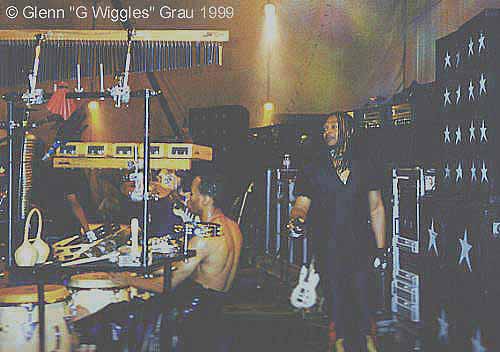
The "Power Piston" speaker concept used today with its inefficient speakers, forces the use of these very high power levels. The artifacts from solid state clipping, solid state switching power supplies, semiconductor noise class of operation, with horns for better "noise" reproduction, along with the RISK of Hang Time cooking the speakers, etc... are present as a by-product of the even more modern technology that is with us for such use today.
The "Power Piston" bass speakers of today lack the full ranged fidelity REQUIRED to reproduce the full spectrum of the natural sounds found in the bass instrument.
With the inclusion of HORNS in the common everyday bass rig of today, to compensate for the lacking highs from the power piston bass speaker,... is this additional horn really going to provide the full spectrum of the natural sounds found in the bass instrument, with the WARMTH that a full ranged high fidelity speaker will?
This bass rig has the full ranged fidelity REQUIRED to reproduce the full spectrum of the natural sounds found in the bass instrument, with the warmth and harmonic richness only vacuum tubes can provide.Welcome to the 400-PS experience.
8. What are those "Power Piston" speakers you talk about?
Power Pistons are:
9. What are the best type of speakers and cabinets to use with a 400-PS?
For Bass or Guitar Speakers:Any single or group of full range speakers of the highest possible sensitivity rating, with a total power rating no lower than 200 watts RMS, to equal 4 ohms per speaker output line of the 400-PS.
Here you see a large modified '70s Fender Dual Showman Reverb cabinet with three 4 ohm JBL K-Series speakers in it. Each of these *full range* K-130 JBL speakers is then connected to one of the three speaker output jacks from the 400-PS.
Yes, that's right. There are three seperate speaker wires connecting this cabinet to the 400-PS.
This configuration can place the full 435 watts of power from the 400-PS on a single speaker cabinet.
For Bass or Keyboards:
Any ported compression cabinet tuned for the lowest frequency to be reproduced.
For example:The Sunn 200-S, 2000-S, or 215 two 15" cabinets.
The Guild Quantum Bass cabinet.
Any properly tuned "W" bin.
Any properly tuned "Scoop" cabinet.
For Guitar:Any extension cabinet designed for guitar applications with properly selected speakers for the 400-PS.
10. Can I get all the power of the 400-PS on one cabinet?
Not without a custom-made output transformer, and/or output stage circuit modification, can it be done properly.11. What's so special about the 400-PS experience?Many amp techs have asked, why can't you use the original existing secondary windings in a series or parallel combination, and get the desired power on one cabinet.
For one reason, transformer windings are NOT like resistors when you tie them in the difference circuit configurations, It simply doesn't work that way. Two 4 ohm resistors in series is 8 ohms. Two 4 ohm windings in series is NOT 8 ohms. In reality,... it is much higher, and is closer to 16 ohms.
Likewise, two 4 ohm resistors in parallel are 2 ohms. Two 4 ohm windings in parallel is NOT 2 ohms. In reality,... it is much lower, and is closer to 1.5 ohms.
If such were to be done, this would place a reflected load on the tubes far from the proper designed tube loading on the primary winding.
Thus, the actual power yield will be far less from the output tube loading mismatch than would be expected, and there is the creation of an increased risk of fly back from the high side loading error.
Now you have the smoked up tube sockets in the 400-PS without knowing why. This is sure to place blame on the 400-PS.... and not the amp tech's ERROR in thinking!
Here is a picture of a smoked up tube socket in a 400-PS, after most all the black carbon had been cleaned off. Notice the scorched wires from the heat of the arc that jumped between pins #2 and #3.
Note the condition of the solder connections on the tube socket from the heat generated by the arc, and the erosion of pins #2 and #3 from the arc. This is a close look at the results of what flyback can do to a tube socket; which, was caused by nothing at this location of the amplifier.
The real answer to this proper impedance loading problem that escapes most amp techs is found in the area where the least creative thought is given. That being,... what is found on the speaker side of the speaker cable.
THE SPEAKER CABINET OPTIONS!!!!!!!!!!!!!!!!!
If the 400-PS won't go to the speakers, *MAKE* the speakers go to the 400-PS.
From the small gig with high sensitivity rated single 4 ohm 15" cab's, to a single monster Acoustic 408 with four high sensitivity rated four 15" speakers,... the modified 400-PS becomes a great all around amp with the vacuum tube tonal harmonics solid state amps can not deliver.
Oh,... the amplifier on the left side of this picture delivers twice the performance of the amp on the right. How could that be possible?
Welcome to the 400-PS experience.
I guess I'll let one of the guys from the 400-PS club answer this question.Subject: Re: [400PS_group] Re: Steve! what year....
Date: Sat, 22 Feb 2003 02:22:02 EST
From: BARTTHOM@AOL.COM
Reply-To: 400PS_group@yahoogroups.com
To: 400PS_group@yahoogroups.comSES,
I USED TO PLAY A G&L B1000 THROUGH A PEAVEY MK IV w/ 1810 CABINET. YEAH, I'M A BASS PLAYER; BUT, WAIT, IT GETS PERTINENT!I PURCHASED A BCRico BASS & FOUND MY SOUND IMPROVED DRAMATICALLY! THEN, IT HAPPENED; THE THEFT OF A LIFETIME.
I WAS ABLE TO RECOVER THE G&L AND I SUPPOSE THE 1810 SPEAKER WAS TOO HEAVY; CAUSE I GOT TO KEEP IT.
HAVING ALWAYS UNDERSTOOD THE AMPEG SVT WAS TOPS, I SEARCHED FOR ONE.
WHAT I FOUND, FOR WHAT I COULD AFFORD & WHAT THE SALESMAN TOLD ME, WAS A FENDER
PS400: "THE DESIGN AMPEG BASED THEIR SVT AMP ON!" RICH HAS SINCE FELLED THAT MYTH !
HOWEVER, I GOT LUCKY, ONCE THE G&L WAS RECOVERED: OH BABY - TALK ABOUT SWEET SOUND!!!
THE PS400 IS AWESOME!! I WAS MERELY PLAYING ONE
CHANNEL AT THE TIME - AND STAYING UP WITH OUR DRUMMER WITHOUT FLEXING or MAXING ANYTHING.NOW, 14 YEARS LATER; WITH THE SAME PS400 & PEAVEY 1810, I USE A VERY SWEET BCRich MOCKINGBIRD BASS WITH ACTIVE ELECTRONICS & I GOTTA TELL YA "I'M ON TOP OF THE WORLD"!!!!!!!!!!!!!!
THE PS400 WILL DELIVER !!!!
THE PS400 WILL SURPRISE!!!!THE PS400 WILL GIVE YOU TONES THAT YOU DID NOT KNOW WERE POSSIBLE!!!!!
HEY, THE BETTER THE INSTRUMENT, THE MORE YOUR DISCOVERY WILL BE!!!!!!!!!!!!!!!!!
HAVE FUN!
ROCKWOOD12. Can I ship my 400-PS to you for repairs?Welcome to the 400-PS experience.No problem. Through the years, many 400-PS amps have broken the backs of the delivery man with Time Electronics on his route. The best thing to do is call for special packing instructions. There is only one way to pack a 400-PS to make the round trip without mishap.
13. Is there some way you can help my amp tech repair my 400-PS?Only under four conditions:1. As Ed Jahns had tested my background and electronics knowledge on the 400-PS over the phone, so will I test any amp tech who seeks my help. There also must be total understanding of the concepts and use of line current observation as it applies to amplifier function and analysis.
2. Digital pictures of all the test gear required to work on the 400-PS must be made available to me before we speak, and the test gear ready with the 400-PS on the bench when we speak on the phone.
3. The amp tech pays for all phone bills.
4. A fee will be charged to cover my time.
14. How can I find out when my 400-PS was made?Through the use of the EIA source codes found on the components used in your 400-PS, you can date it's birth. CLICK HERE for a great web site that applies these source codes to vintage amplifiers.
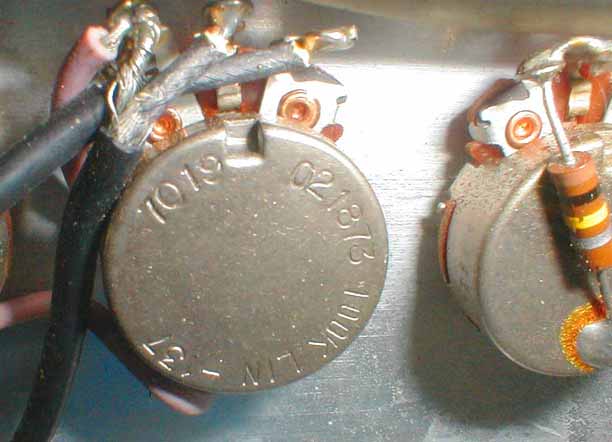
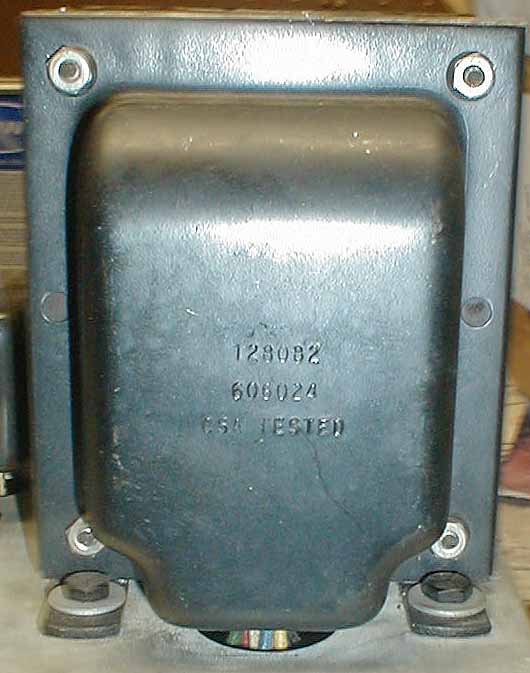
15. How can I find out what my 400-PS is worth?
Perform a search on Ebay's completed 400-PS auctions. That is always a great place to start.
16. Are there any mods that can be done to the 400-PS?
Most of the standard Fender amp mods that involve the pre-amp, tremolo, and reverb stages, can be performed on the 400-PS.There are power increase mods too.
17. I found a broken down 400-PS for sale. Do you think I should buy it?
Ed Jahns was from the old school of product design, and designed the 400-PS to be as strong as a bullet proof brick shit house. I NEVER found a 400-PS that was beyond repair.Yes, 400's will put on a light show with a good smoke screen. But let us not forget for one second, that UL sticker that resides on the back panel of the 400-PS.
Ed and I talked a lot about the tests the UL people would subject the 400-PS through, in order to fry the damn thing up. Many times Ed would get a 400 back from UL a complete mess.
Yet, all he had to do was clean up the mess, replace any smoked components, broken tubes, etc... and the 400 was back up and running. Then, Ed would send it back for the next round of amp torture that UL would put the 400 through.
I got my 400-PS for dirt because the so called amp tech at the store said the transformers were blown. I replaced the fried parts, installed a fresh set of tubes, and it fired right up without a problem.
As a matter of fact, the melted tube on this page, was one of two side by side melted tubes that was in my 400-PS when I drove it home from that store.
I have yet to find a 400-PS on my bench with an actual blown tranny.
It's just a matter of how cost effective the selling price is to make the resurrection from the dead worth while.
18. What are the best basses to use with a 400-PS?
Fender amps were always designed to make Fender instruments sound their best through Fender amplifiers. So logic would have it that, the Jazz Bass, P-Bass, and Bass VI would be the basses to use with the 400-PS.19. My solid state amp blew speakers often. Will the 400-PS do the same?However, you haven't lived till you've heard a Gibson Thunderbird IV, Explorer, or EB-2 Bass on a 400-PS rig!
However, today's basses would do very well with a 400-PS.
Imagine the extraordinary harmonic content of a seven string bass being reproduced with the hallmark headroom of the 400-PS, with the harmonic enrichment of vacuum tubes.
The seven string bass and the 400-PS were made for each other.
Solid state amplifiers, when a square wave is introduced anywhere in the signal chain, will produce speaker *hang time*. Which is a slow death for any speakers connected to that amp. 600 watt speakers are easily toasted by a solid state 300 watt amp run in hang time.Vacuum tube amps can't produce enough DC current to hold speakers in hang time at the lower frequencies. This is due to the nature of the output transformer's electrical function in a vacuum tube amplifier.
20. Did any famous bands use the 400-PS amp?
Heart, Poco, Chicago, Ike and Tina Turner, The Allman Brothers, and Albert King are a few I've been told about.21. Are there any Do's and Don'ts I should know about when using a 400-PS?
Note the two 400's in this picture with a very young Tina Turner.
I'm always looking for 400-PS sightings in old concert photos.
1. Always make sure all speaker cabinets are properly connected to the output jacks, BEFORE turning on a 400-PS.22. What are the Fender specs for the 400-PS?2. Always warm up the tubes for a few minutes before playing.
3. Always let the tubes cool to room temperature, BEFORE loading out the 400-PS.
4. Never let an amp tech without prior 400-PS experience work on your 400-PS.
5. Always use the best output tubes possible. If you have read this far, you already know which tubes they are.
6. NEVER think of using a tranny toast (power attenuator) on a 400-PS.
7. Only connect 4 ohm loads to the speaker output jacks. Otherwise, you are looking for trouble.
Year: 1970-1975 Model: 400 PS Bass Config: Piggy-back Control Panel: Black forward facing with white labels Front Control Layout: Power Sw, Standby Sw, Pilot Lamp - Bass: In, In, Deep Sw, Vol, Treb, Bass - Normal: In, In, Bright Sw, Vol, Treb, Mid, Bass, Reverb, Speed, Intensity - Master Volume Rear Conrol Layout: Speaker Out, Speaker Out, Speaker Out, Output Tubes Matching, Tremolo Ft Sw Jack, Reverb Ft Sw Jack, Fuse, Ground Sw Knobs: Chrome skirted w/ black "F" center, numbered 1 - 10 Head: 11½½" x 28" x 12¾¾" (29.2 x 71.1 x 32.4 cm) Head Hardware: Black strap handle, corner protectors Cabinet: 48" x 24" x 24" (121.9 x 61 x 61 cm) Cab Hardware: corner protectors, casters Head/Cab Covering: Black Tolex Head/Cab Grille: Blue grille cloth (70-72) or black acoustic foam w/ white trim (72-75) Logo: Grille mounted, "Fender"with tail (head & cab) Weight: Head: 84 lbs. (38.1 Kg) Cab: 126 lbs. (57.2 Kg) Speakers/Load: 1 x 18"/4 ohms Effects: Tremolo, Reverb Output: 435 Watts (3 x 145 Watts) Preamp: 2 x 7025 tubes Power: 6 x 6550 tubes Bias: Fixed Bias Rectifier: Solid State Phase Inverter: 1 2AU7, 6L6GC, Transformer Other: Reverb Driver: 12AT7 Reverb Recovery: 7025 Tremolo: 12AX7 (photo resistor) Comments: The output was divided into three 145 Watt outputs, so three cabs were needed to get the entire 435 Watts. Fender included a wheeled stand for the head at no extra charge.
23. What is the advantage of having a 400-PS over an SVT?
Twice the power for the same weight, favors the 400-PS head big time!!!!The Ampeg Book's page 150 states the weight of the SVT head is 85 lbs.
Fender lists the weight of the 400-PS head as 84 lbs.Welcome to the 400-PS experience.
24. What output stage CLASS of operation is used in the 400-PS?
25. Can the KT-88, or other output tubes be used in the 400-PS?

© Copyright R.K.Koerner 2001 All Rights
Reserved.
|